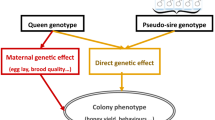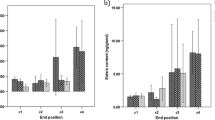Summary
The drone population at a natural drone congregation area (DCA) was composed of 50%Apis mellifera ligustica (L) and 50%Apis mellifera carnica (C) drones. Both kind of drones were monitored by frequent sampling. Significant differences in the vertical drone distribution were detected: at 4 meters the portion of L drones was larger and C drones were relatively more frequent in 20 meters. Virgin queens (L and C) were naturally mated in the DCA and mating frequencies for L and C drones were established. Their worker offspring was classified as pure Ls. pure Cs or hybrids. A significant tendency for assortative mating was found for both groups of queens. One of the mechanisms of mate choice may involve the differences in vertical distribution of the drones.
Zusammenfassung
Die Drohnenpopulation eines natürlichen Drohnensammelplatzes wurde zu 50% aus Drohnen vonApis mellifera ligustica (L) and zu 50% ausApis mellifera carnica (C) Drohnen zusammengesetzt. Durch kontinuierlich durchgeführte Drohnenfänge wurde die Relation beider Drohnenrassen überprüft. Es wurden signifikante Unterschiede in der Höhenverteilung der Drohnen gefunden: In 4 m Höhe war der relative Anteil der L-Drohnen größer als in 20 m und entsprechend waren die C-Drohnen in 20 m Höhe relativ häufiger als in 4 m. Jungfräulichen Königinnen (L und C) wurde der ungehinderte Hochzeitsflug auf dem Drohnensammelplatz gestattet. Die von diesen Königinnen produzierten Arbeiterinnen konnten als reine L-, reine C-Bienen oder als Hybriden bestimmt werden. Auf diese Weise waren Aussagen über die Paarungsfrequenz möglich. Sowohl die C- als auch die L-Königinnen hatten mehr rassereine Nachkommen als Hybriden. Daraus ergab sich für beide Rassen eine Bevorzugung von Paarungen innerhalb der Rasse. Eine rassespezifisch unterschiedliche Flughöhe beim Hochzeitsflug der Königinnen könnte zu diesen Paarungsergnis beigetragen haben.
Similar content being viewed by others
References
Drescher W., 1969. — Die Flugaktivität von Drohnen der RasseApis mellifera carnica undApis mellifera ligustica in Abhängigkeit von Lebensalter und Witterung.Z. Bienenforsch., 9, 390–409.
Haas A., 1946. — Neue Beobachtungen zum Problem der Flugbahnen bei Hummelmännchen.Zeitschr. Naturforsch., 1, 596–600.
Harbo J., 1971. — Annotiated bibliography on attempts at mating honeybees in confinment.Bee Research Association, Bibliography 12, 14 pp., Cardiff, GB.
Kerr W.E., Bueno D., 1970. — Natural crossing betweenApis mellifera adansonii andApis mellifera ligustica.Evolution, 24, 145–148.
Koeniger G., 1986. — Mating sign and multiple mating in the honeybee.Bee World, 67, 141–150.
Koeniger G., Koeniger N., Fabritius M., 1979. — Some detailed observations of mating in the honeybee.Bee World, 60, 53–57.
Koeniger N. Wijayagunasekera H.N.P., 1976. — Time of drone flight in the three Asiatic honey bee species (Apis cerana, Apis florea, Apis dorsata).J. Apic. Res., 15, 67–71.
Koeniger N., Koeniger G., Tingek S., Mardan M., Rinderer T.E., 1988. —Reproductive isolation by different time of drone flight betweenApis cerana Frabritius 1793 andApis vechti Maa 1953.Apidologie, 19, 103–106.
Laidlaw H.H. Jr,Page R.E. Jr., 1984. — Polyandry in honey bees (Apis mellifera): Sperm utilization and intracolony genetic relationships.Genetics, 108, 985–997.
Loper G.M., Wolf W.W., Taylor O.R. Jr., 1987. — Detection and monitoring of honeybee drone congregation areas by radar.Apidologie, 18, 163–172.
Ruttner F., 1987. —Biogeography and taxonomy of the honeybees. Springer-Verlag, Berlin.
Moritz R.F.A., 1986. — Intracolonial worker relationship and sperm competition in the honeybee (Apis mellifera L.).Experientia, 42, 445–448.
Ruttner H., Ruttner F., 1972. — Untersuchungen über Flugaktivität und das Paarungsverhalten der Drohnen. 5. Drohnensammelplatz und Paarungsdistanz.Apidologie, 3, 203–232.
Taylor O.R. Jr., 1984. — An aerial trap for collecting drone honeybees in congregation areas.J. Apic. Res., 23, 18–20.
Woyke J., 1960. — Natural and artificial insemination of queen honeybees.Pszozelinicze Zeszyty Nankowe, 4, 183–275.
Woyke J., 1963. — Wirkung aufeinanderfolgender Drohnen auf die Besamung der Königin19th Apimondia-Kongress Prag, 550–552.
Author information
Authors and Affiliations
Rights and permissions
About this article
Cite this article
Koeniger, G., Koeniger, N., Pechhacker, H. et al. Assortative mating in a mixed population of European Honeybees,Apis mellifera ligustica andApis mellifera carnica . Ins. Soc 36, 129–138 (1989). https://doi.org/10.1007/BF02225908
Received:
Accepted:
Issue Date:
DOI: https://doi.org/10.1007/BF02225908




